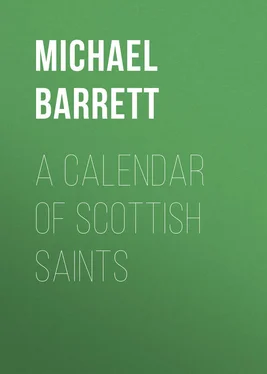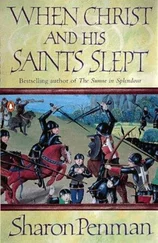Michael Barrett - A Calendar of Scottish Saints
Здесь есть возможность читать онлайн «Michael Barrett - A Calendar of Scottish Saints» — ознакомительный отрывок электронной книги совершенно бесплатно, а после прочтения отрывка купить полную версию. В некоторых случаях можно слушать аудио, скачать через торрент в формате fb2 и присутствует краткое содержание. Жанр: foreign_antique, foreign_prose, на английском языке. Описание произведения, (предисловие) а так же отзывы посетителей доступны на портале библиотеки ЛибКат.
- Название:A Calendar of Scottish Saints
- Автор:
- Жанр:
- Год:неизвестен
- ISBN:нет данных
- Рейтинг книги:5 / 5. Голосов: 1
-
Избранное:Добавить в избранное
- Отзывы:
-
Ваша оценка:
- 100
- 1
- 2
- 3
- 4
- 5
A Calendar of Scottish Saints: краткое содержание, описание и аннотация
Предлагаем к чтению аннотацию, описание, краткое содержание или предисловие (зависит от того, что написал сам автор книги «A Calendar of Scottish Saints»). Если вы не нашли необходимую информацию о книге — напишите в комментариях, мы постараемся отыскать её.
A Calendar of Scottish Saints — читать онлайн ознакомительный отрывок
Ниже представлен текст книги, разбитый по страницам. Система сохранения места последней прочитанной страницы, позволяет с удобством читать онлайн бесплатно книгу «A Calendar of Scottish Saints», без необходимости каждый раз заново искать на чём Вы остановились. Поставьте закладку, и сможете в любой момент перейти на страницу, на которой закончили чтение.
Интервал:
Закладка:
It is a common feature in the Celtic designations of saints to find the prefix mo (my) and the affix og (little) added to the simple name by way of reverent endearment. This is the case in the names just referred to; Kilmaronog and Kilmaronock both mean literally "Church of my little (or dear) Ronan."
Many legends surround this saint, but very little authentic information can be gleaned concerning the circumstances of his life. Many dedications to him are to be found on lonely isles and retired spots on the west coast, which seem to point to a custom of seeking solitude from time to time. Thus a little island near Raasay is called Ronay; another sixty miles north-east of the Lewes, possessing an ancient oratory and Celtic crosses, is called Rona. An islet on the west coast of the mainland of Shetland is called St. Ronan's Isle; it becomes an island at high tide only. The parish church of Iona was called Teampull Ronain and its burial ground Cladh Ronain . St. Ronan is said to have been Abbot of Kingarth, Bute, where he died in 737. Holy wells bear his name at Strowan (Perthshire), Chapelton in Strathdon (Aberdeenshire), and the Butt of Lewis; the latter is famed for the cure of lunacy.
14 – St. Conran.
He was a Bishop of Orkney in the seventh century whose name was illustrious for sanctity, zeal, and austerity of life.
17 – St. Finan, Bishop, A.D. 661.
This saint was an Irishman who became a monk in the monastery founded by St. Columba at Iona. During his monastic life he was distinguished for the virtues befitting his state, especially prudence and gravity of demeanour. He was devoted to prayer and strove zealously to live according to the Divine Will in all things. When St. Aidan, who had been a monk of Iona, passed to his heavenly reward, a successor in his see of Lindisfarne was again sought in that celebrated monastery, and the choice fell upon Finan. His first care was to erect on the island of Lindisfarne a suitable cathedral, and in this he placed the remains of his saintly predecessor Aidan.
During the few years that St. Finan ruled his diocese he exhibited all the virtues of a model bishop. His love of poverty, contempt of the world, and zeal for preaching the Gospel, won the hearts of his people. Under his guidance, Oswy the King was brought to realise his crime in the barbarous murder of the saintly Oswin, King of Deira, and the result was the foundation of monasteries and churches as tokens of his sincere repentance and his desire to obtain pardon from Heaven through the prayers and merits of those who should dwell in them.
The influence of St. Finan extended beyond his own people; for the kings of more southern nations, with their subjects, owed the Faith to his zeal and piety. Peada, King of the Mercians, and Sigebert, King of the East Saxons, both received Baptism at his hands, and obtained from him missionaries to preach to their respective peoples.
The most famous work in which St. Finan was directly concerned was the foundation by Oswy of the Monastery of Streaneshalch on the precipitous headland afterwards known as Whitby. This was to become in later years, under the rule of the first abbess, Hilda, a school of saints and a centre of learning for the whole territory in which it stood, and the admiration of after ages for its fervour and strictness of discipline.
St. Finan died after an episcopate of ten years, and was laid to rest beside the remains of St. Aidan in the cathedral he had built at Lindisfarne. His feast was restored to Scot land by Leo XIII. in 1898.
18 – St. Colman, Bishop, A.D. 676.
On the death of St. Finan, another monk of Iona was chosen to succeed him in the see of Lindisfarne. This was Colman, who, like Finan, was of Irish nationality. At the time a fierce controversy was raging in Britain as to the correct calculation of Easter. The Roman system of computation had undergone various changes until it was finally fixed towards the end of the sixth century. It was adopted gradually throughout the Church, but Britain and Ireland still retained their ancient method. In consequence of this it sometimes happened that when the Celtic Church was keeping Easter, the followers of the Roman computation were still observing Lent. This was the case in the Court of Oswy, King of Bernicia, who followed the Celtic rite, while his Queen Eanfleada and her chaplains, who had been accustomed to the Roman style, kept the festival in accordance with it.
To bring about uniformity a synod was held at Whitby to give the advocates of either system an opportunity of stating their views. St. Wilfrid, the great upholder of Roman customs, brought such weighty arguments for his side that the majority of those present were persuaded to accept the Roman computation. St. Colman, however, since the Holy See had not definitely settled the matter, could not bring himself to give up the traditional computation which his dear master, St. Columba, had held to. He, therefore, resigned his see, after ruling it for three years only, and with such of the Lindisfarne monks as held the same views retired to Iona.
On his way thither he seems to have founded the church of Fearn in Forfarshire, which he dedicated to St. Aidan, placing there some of the saint's relics brought with him from Lindisfarne. He also founded a church in honour of the same saint at Tarbert in Easter-Ross. This, however, was afterwards called by his own name.
After a short stay at Iona, St. Colman re turned to Ireland and founded a monastery at Inisbofin, an island on the west coast of that country, peopling it with the monks who had left Lindisfarne in his company. Later on a new foundation was made at Mayo for Saxon monks only; it became known as "Mayo of the Saxons." The saint ruled both monasteries till his death, which occurred at Inisbofin, where he was buried. He had translated thither the greater part of St. Aidan's relics. The ruins of the ancient church may still be seen on the island. St. Colman's feast has been restored to Scotland by Pope Leo XIII.
Protestant writers have tried to interpret St. Colman's conduct regarding the Synod of Whitby as a manifest opposition to Roman authority. This, however, is a mistaken conclusion. It must be remembered that the matter was regarded by him as an open question, and he considered himself justified in keeping to the traditional usage until Rome declared against it. St. Bede, who had no sympathy with his views on the Easter question, speaks highly of St. Colman as a holy and zealous Bishop.
There is some discrepancy between Scottish and Irish authorities as to the precise date of the saint's death. In Scotland he was honoured on this day, but Irish writings give the date as August 8. There are also some slight differences in the particulars of his life; but as no less than 130 saints of this name are mentioned in Irish ecclesiastical records, it is conceivable that their histories have become intermixed.
23 – St. Boisil, Confessor, A.D. 664.
The old abbey of Melrose was not the Cistercian house whose ruins still remain, but an earlier monastery which had been founded by St. Aidan and followed the rule of St. Columba, which was afterwards changed for that of St. Benedict. The Roman usage regarding Easter was adopted there, very soon after the Synod of Whitby. Its abbot was the holy Eata, who was given the government of Lindisfarne Abbey also, when many of its monks followed St. Colman to Ireland. Just before these events occurred the subject of this notice was called to his reward. He was prior of Melrose under Eata, and it was he, who, being a monk and priest of surpassing merit and prophetic spirit, as St. Bede says, welcomed with joy and gave the monastic habit to a youth in whom he saw "a servant of the Lord" – the future St. Cuthbert. The two became devoted friends, and Boisil, who was especially learned in the Scriptures, became Cuthbert's master in that science, as well as his example in holy living.
Читать дальшеИнтервал:
Закладка:
Похожие книги на «A Calendar of Scottish Saints»
Представляем Вашему вниманию похожие книги на «A Calendar of Scottish Saints» списком для выбора. Мы отобрали схожую по названию и смыслу литературу в надежде предоставить читателям больше вариантов отыскать новые, интересные, ещё непрочитанные произведения.
Обсуждение, отзывы о книге «A Calendar of Scottish Saints» и просто собственные мнения читателей. Оставьте ваши комментарии, напишите, что Вы думаете о произведении, его смысле или главных героях. Укажите что конкретно понравилось, а что нет, и почему Вы так считаете.












